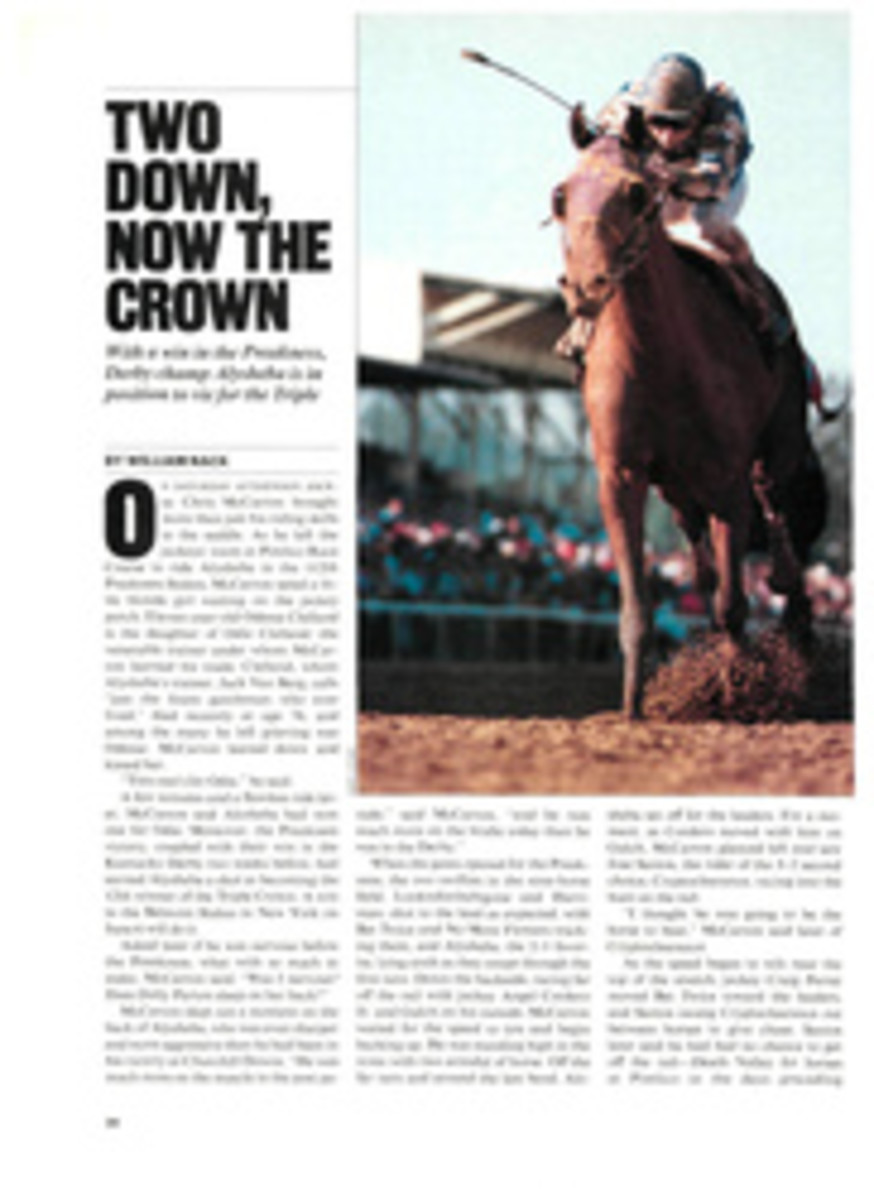
LORD OF THE WATERWAYS
One summer day in 1818, Venetians strolling along the Grand Canal were treated to an unusual sight. A stylishly dressed man leaving one of the palaces walked straight to the edge of the canal and, without so much as loosening his cravat, dived in and swam away. He was neither drunk nor crazy: Lord Byron just wanted to get home as quickly as possible.
Today, more than 150 years later, Byron's name has come to stand as much for licentiousness as for brilliant Romantic poetry. But Byron coupled his wildness with a deep love of sport and the outdoors. From his boyhood days in Scotland, where he swam in the Dee and the Don rivers, Byron insisted on regular, rigorous exercise. The exertion brought relief from the gloomy moods he sometimes suffered. "The more violent the fatigue," he noted in his journal in 1814, "the better my spirits for the rest of the day." For example, instead of attending his mother's funeral, the distraught 23-year-old Byron vigorously boxed with a close friend. Byron mastered a wide variety of sports. In addition to swimming, he fenced, sculled, rode and shot at targets. At Harrow he was a good enough cricketer to play for the first team against Eton. When he needed a sparring partner, Byron hired John (Gentleman) Jackson, a former British champion.
Of course, in those days it was not unusual for a young lord to spend his free time enjoying sports. But one thing did make Byron exceptional as a sportsman. His right foot was severely deformed from birth. It twisted inward, forcing him to walk on its side. For the proud Byron, sport was a means to an end: He used it as he did women—to prove to both the world and himself that he was as much a man as anyone else. His good friend Mary Shelley, author of Frankenstein, went so far as to say that "no action of Lord Byron's—scarce a line he has written—but was influenced by his personal defect."
Swimming became Byron's first love because his deformity was less of a handicap in it than in other sports. Although Byron swam in many of England's rivers, his most ambitious swims took place on the Continent. Some people tour the great cathedrals of Europe, some the great museums. Byron took a "great waterways" tour, and he insisted on getting to know his subject firsthand.
Byron was 21 in 1809, when he first visited Europe. As he would on many later trips, he took with him his close friend John Cam Hobhouse. For two years the pair traveled around the Mediterranean, where, inspired by the rich literary associations of his surroundings, Byron began Childe Harold's Pilgrimage, the first of his major poems. Throughout the journey he continued to swim, and by April 1810 he was ready for his best-known athletic feat, his swim across the Hellespont, the mile-wide channel that separates European Turkey from Asiatic Turkey.
From his reading of classical literature, Byron knew the myth of Hero and Leander, two lovers who lived on opposite sides of the Hellespont. Each night, Leander swam from his own home in Abydos on the Asian shore to Hero's in Sestos on the European shore. The two then spent the night together before Leander swam home at dawn. Byron, who drew no distinction between mythical and flesh-and-blood rivals, was determined to match Leander's feat.
On their first attempt to cross the Hellespont, Byron and a companion, Lieutenant Ekenhead, misjudged the strength and direction of the current. After an hour in the water, they were only halfway across and decided to give up. Two weeks later they were ready to try again. With Hobhouse watching from a nearby ship, Byron and Ekenhead entered the water shortly after 10 in the morning. Swimming strongly and making better use of the current, Byron and Ekenhead finally reached land about three miles below their starting point. Hobhouse noted "Lord Byron was an hour and ten minutes in the water; his companion, Mr. Ekenhead, five minutes less." To that, Byron added that, despite a strong current, "[we] were not fatigued...and did it with little difficulty."
Byron was never one to keep quiet about his accomplishments. Not only did he write a poem to celebrate the occasion (Written After Swimming from Sestos to Abydos), but he also referred to it in letters for months afterward. To his mother he wrote, "I believe I mentioned to you in my last letter that my only notable exploit lately has been swimming from Sestos to Abydos on the 3d. of this month, in humble imitation of Leander of amorous memory, though I had no Hero to receive me on the other shore of the Hellespont." His friend Henry Drury received a racier version: "The immediate distance is not above a mile but the current renders it hazardous, so much so that I doubt whether Leander's conjugal powers must not have been exhausted in his passage to Paradise."
The next year Byron went home to England. But in 1816 he returned to Italy and lived at different times in Venice, Rome and Pisa. In Venice particularly he kept up a remarkable pace, working furiously on Don Juan, socializing and carousing. By his own reckoning he had 200 affairs in 1819 alone. One of his friends, Countess Albrizzi, recalled that he especially enjoyed swimming at night, when, to warn drowsy gondoliers of his presence, he would propel himself with his right arm while holding a torch up with his left.
One night at a party Byron met an Italian count named Mengaldo. The two shared many interests—literature, politics and women, to name a few. But what Byron found most fascinating about Mengaldo was that he claimed to have swum across both the Berezina and Danube rivers under enemy fire while fighting for Napoleon. Byron didn't need to hear any more. Before leaving the party he challenged Mengaldo to a race. The swim was to be an ambitious one, even by Byron's standards. From the Lido, a sliver of land on the Adriatic Sea, the two men were to swim well over a mile to the eastern mouth of the Grand Canal and down the length of the canal itself, a distance of more than four miles.
Late on the afternoon of race day, Mengaldo, Byron and a third swimmer, a friend of Byron's named Alexander Scott, were ferried by gondola out to the Lido. At 4:30, with the sun-lit spires of Venice gleaming across the water, the race began. It quickly became apparent that Byron and Scott were far better swimmers than Mengaldo. By the time Byron and Scott reached the mouth of the Grand Canal, they were 500 yards ahead of him, beating him, as Byron later put it, "all to bubbles." Scott, too, was soon left behind and climbed out of the water midway through the canal.
Byron could have stopped at this point with no loss of honor. He had won decisively. But Byron was not about to stop. In a letter to Hobhouse he proudly declared that "I swam from Lido right to the end of the Grand Canal, including its whole length.... The whole distance was computed by the Venetians at four and a half of Italian miles. I was in the sea from half past four till a quarter past 8 without touching or resting."
Despite all his exercising, Byron was anything but a picture of health. A visitor reported to friends in England that "Lord Byron could not have been more than 30, but he looked 40. His face had become pale, bloated, and sallow." Indeed, Byron wrote to Hobhouse with the wistfulness of a much older man, "At thirty-one, so few years, months, days remain, that "Carpe diem" is not enough.... I can not repent me (I try very often) so much of anything I have done, as of anything I have left undone."
Byron could not stop doing. In 1823 he moved to Greece to throw all of his energies into the country's war of independence. Although his health continued to deteriorate, he rode almost daily, pushing himself mercilessly. Returning home from a ride one day, he was caught in a violent downpour. That night he developed a severe fever. Still, he went out riding the next day. It would be the last time he left his house. Byron died two days later, on April 19, 1824, four months after his 36th birthday.
PHOTO
CULVER PICTURES
Byron noted in his journal that rigorous excerise lifted his spirits.
ILLUSTRATION
ENGRAVING BY EDWARD FINDEN
As a boy in Scotland, Byron excelled at many sports.

